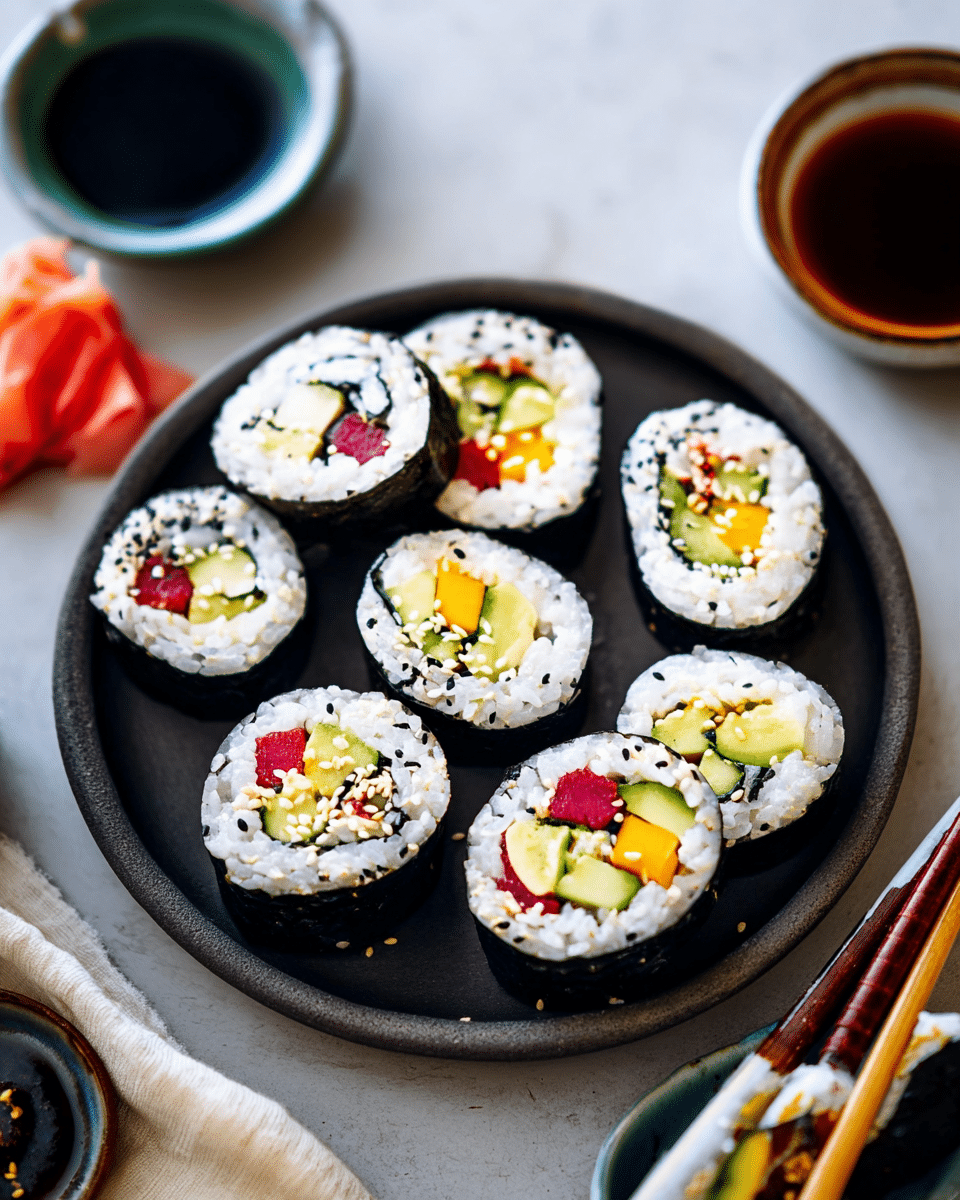These Vegetarian Sushi Rolls are a celebration of color, texture, and flavor. With creamy avocado, crunchy cucumber, seasoned rice, and a bold spicy mayo kick, each bite is a perfect harmony. They’re rolled in savory nori sheets and sliced into bite-sized delights—ideal for lunchboxes, potlucks, or a light and nourishing dinner.
What makes this recipe shine is its customizability—swap or add in seasonal veggies, microgreens, or even pickled radish for a twist. No sushi-grade fish? No problem. These rolls pack satisfaction in every plant-based bite and make sushi night fun and inclusive for everyone.
Full Recipe:
For the Sushi Rice:
-
2¼ cups Japanese short-grain rice
-
2¼ cups water
-
1 piece kombu (2″x2″, optional)
-
⅓ cup seasoned rice vinegar
For the Pickled Red Onion:
-
½ red onion, thinly sliced
-
½ cup seasoned rice vinegar
For the Spicy Mayo:
-
¼ cup Japanese Kewpie mayo (or vegan mayo)
-
1 tbsp sriracha
-
Splash of lime juice
For the Rolls:
-
6 sheets of nori (seaweed)
-
2 Japanese or Persian cucumbers, cut into strips
-
1 carrot, julienned
-
1 avocado, sliced
-
1 deep-fried firm tofu cutlet (atsuage), sliced into strips
-
White sesame seeds (optional garnish)
Directions:
-
Rinse rice until the water runs clear. Cook with water and kombu in a rice cooker or pot. Discard kombu post-cooking.
-
While the rice is hot, pour in the seasoned rice vinegar. Use a slicing motion to mix and fan the rice to cool it to room temperature. Cover with a damp cloth.
-
Pickle red onion slices in seasoned rice vinegar. Set aside.
-
Combine mayonnaise, sriracha, and lime juice to make spicy mayo.
-
Prepare cucumber, carrot, tofu, and avocado for rolling.
-
Place a nori sheet shiny side down on a bamboo mat. Spread 1 cup of sushi rice, leaving a ½ inch border at the top.
-
Spread a line of spicy mayo, then layer cucumber, avocado, tofu, carrot, and pickled onions.
-
Roll the sushi tightly using the bamboo mat, then slice into 8 pieces with a sharp, dampened knife.
-
Repeat with remaining ingredients. Serve with soy sauce, wasabi, and pickled ginger.
Prep Time: 45 minutes | Cooking Time: 1 hour | Total Time: 1 hour 45 minutes
Kcal: 501 kcal | Servings: 6 rolls
History and Origin
Sushi is one of Japan’s most iconic foods, with a history that dates back over a thousand years. Originally, sushi was created as a way to preserve fish by fermenting it with rice. Over time, the dish evolved into the more familiar form we recognize today—fresh fish served atop vinegared rice. However, sushi has not always been the seafood-centric dish we know it as now. In fact, vegetarian sushi has always been a popular option in Japan, especially among those who prefer plant-based foods or follow dietary restrictions.
Vegetarian sushi rolls, also known as shushi maki or simply maki sushi, have become a favorite worldwide, particularly in areas where the demand for plant-based meals is growing. These rolls are an adaptation of the traditional sushi roll, which typically includes fish, and instead focus on fresh vegetables and tofu, making them suitable for vegetarians and vegans alike. While Japan doesn’t traditionally label sushi as vegetarian, the global demand for vegetarian options has helped create more awareness and availability of these plant-based rolls.
Variations and Adaptations
One of the beauties of vegetarian sushi rolls is their adaptability. The base ingredients—rice and nori (seaweed)—remain constant, but the fillings can be as varied as your imagination allows. In Japan, you might find variations that feature pickled vegetables like takuan (pickled daikon) or roasted mushrooms. These flavors add a depth of umami that makes the rolls irresistible.
For those who are looking for a lighter version, cucumber and avocado are frequently used as the main ingredients, providing a fresh, creamy texture. Other vegetable options include julienned carrots, bell peppers, and radishes, all of which contribute a satisfying crunch. Additionally, the use of tofu as a filling is a common choice, either as deep-fried or firm tofu cut into sticks. The tofu adds a hearty, savory element to balance the freshness of the vegetables.
For a bit of heat, many vegetarian sushi rolls include spicy mayo, made from Kewpie mayonnaise and sriracha, which gives a nice creamy kick. There are also variations that incorporate pickled red onions, which lend a tangy bite that contrasts beautifully with the creaminess of the avocado.
In other regions, such as North America, sushi chefs have begun experimenting with non-traditional ingredients like fruits (think mango, papaya, or even pineapple) to create fusion sushi rolls. These fruit-based rolls pair especially well with sweet chili sauces or even a drizzle of honey for a unique twist.
Nutritional Information
Vegetarian sushi rolls are not only a tasty option but also a nutritious one. Packed with vegetables and plant-based proteins, they offer an excellent balance of macronutrients—healthy fats, carbohydrates, and proteins—along with essential vitamins and minerals.
Each roll typically contains around 500 kcal, though this can vary depending on the fillings used and the portion size. The main source of carbohydrates comes from the sushi rice, which is typically made with Japanese short-grain rice. This rice has a higher starch content, making it sticky and perfect for rolling. While the rice provides an energy boost, it’s worth noting that sushi rice is usually seasoned with vinegar, sugar, and salt, so you might want to adjust the amount of seasoning if you’re watching your sodium intake.
The addition of avocado brings a healthy dose of unsaturated fats, particularly monounsaturated fats, which are beneficial for heart health. Tofu, especially firm or fried tofu, is an excellent plant-based protein source, rich in essential amino acids, calcium, and iron. Vegetables like cucumber, carrot, and bell peppers are low in calories and provide a rich source of dietary fiber, vitamin C, and other antioxidants that help fight oxidative stress and promote overall health.
On top of that, nori (seaweed) is an excellent source of iodine, a mineral that supports thyroid function, and it also contains a variety of vitamins, including vitamin A, C, and B12.
While vegetarian sushi rolls can be quite balanced, it’s important to be mindful of the sodium content, especially if you’re using soy sauce or spicy mayo as condiments. Opting for a low-sodium soy sauce or using the condiments sparingly can help keep things in check.
Serving Suggestions and Pairings
Vegetarian sushi rolls are as versatile in their pairings as they are in their fillings. They can be enjoyed on their own as a light meal or appetizer, but they also work well as part of a larger spread. Serve them with traditional Japanese sides like edamame (steamed soybeans), miso soup, or a simple cucumber salad.
If you want to go the extra mile, pair your sushi rolls with a refreshing cup of green tea, which is known for its health benefits, including its antioxidant properties. For those who prefer something a little more indulgent, you can serve the rolls with a chilled bottle of sake or a light white wine such as Sauvignon Blanc or Chardonnay, both of which complement the fresh flavors of the sushi.
For dessert, try pairing the sushi with a light and refreshing fruit-based dish, such as a simple fruit salad or even Japanese mochi (sweet rice cakes) for a more authentic touch.
Tips and Tricks for Success
Sushi making can seem intimidating at first, but with a few tips, you can make your vegetarian sushi rolls with confidence.
Advertisement
-
Use the Right Rice: Sushi rice is a must. It has a sticky texture that makes rolling much easier. If you can’t find sushi rice, try using short-grain rice as a substitute. Just make sure it’s sticky enough to hold together when rolled.
-
Don’t Overfill: It’s easy to get carried away with all the fillings you want to include, but less is more when it comes to sushi rolls. Overfilling will make it difficult to roll tightly, and the ingredients might spill out. Stick to 2-3 fillings per roll for the perfect balance.
-
Wet Your Hands: When working with sushi rice, wet your hands with a bit of water to prevent the rice from sticking to your fingers. This will help ensure a smooth and clean rolling process.
-
Use a Sharp Knife: After you’ve rolled your sushi, use a very sharp knife to slice it. A dull knife will squish the rolls, while a sharp one will make clean cuts, leaving the sushi looking beautiful and intact.
-
Roll Gently but Firmly: Rolling sushi requires a gentle touch, but don’t be afraid to apply a little pressure to ensure the roll stays compact. Using a bamboo mat makes it much easier to get an even, tight roll.
Potential Health Benefits
Vegetarian sushi rolls are not only a tasty and satisfying meal but also come with several health benefits thanks to their wholesome ingredients. The combination of fiber-rich vegetables, heart-healthy fats from avocado, and protein-packed tofu makes these rolls an excellent choice for anyone looking to eat more plant-based meals.
Nori, the seaweed used to wrap the rolls, is a fantastic source of vitamins and minerals, including iodine, which is essential for proper thyroid function. The omega-3 fatty acids found in avocado help reduce inflammation and promote healthy skin and joints. Additionally, the antioxidants found in the vegetables used in sushi rolls, such as carotenoids in carrots and bell peppers, contribute to a healthy immune system and can support eye health.
The tofu provides a good source of plant-based protein, making this dish an excellent option for vegetarians and vegans. It also helps to maintain muscle mass and supports various body functions, such as hormone regulation.
Conclusion
Vegetarian sushi rolls are a delightful and healthy option for those looking to enjoy the flavors of sushi without the seafood. Whether you’re making them for a party, a family meal, or a fun cooking experience, they’re sure to be a crowd-pleaser. With their vibrant colors, fresh ingredients, and endless customization options, these rolls are not only delicious but also a great way to introduce more plant-based foods into your diet. So, grab your bamboo mat and get rolling—your next sushi adventure awaits!






